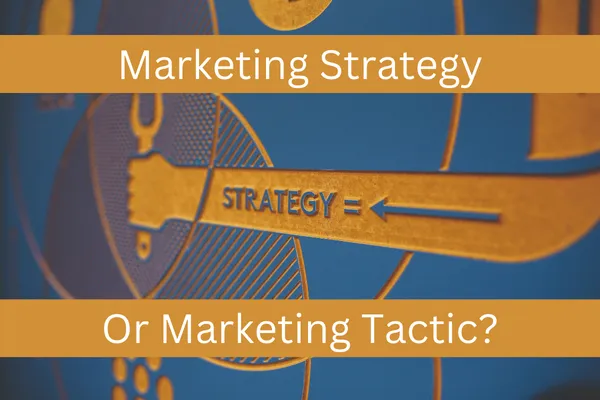
Common Small Business Marketing Strategies You Can Start Using Today
Common Small Business Marketing Strategies You Can Start Using Today
Small business marketing strategies are probably one of the most misunderstood things in all of marketing.
“Try Facebook!”
“Know Your Audience!”
“Increase Your Organic Traffic!”
The list goes on. Just Google “Small Business Marketing Strategies” and you’ll see lists upon lists of things “you should be doing to grow your business.”
If you’ve spent any amount of time trying to find a small business marketing strategy, you’re probably not satisfied with what you’ve found. And there’s a good reason for that! The first page of Google for “small business marketing strategies” contains 0 information on actual small business marketing strategies. In fact, that entire page is full of nothing but marketing tactics (which are nearly useless, or at best wasteful, without an actual strategy framework).
Let’s define a few terms before we continue, all of which will be important to understand if you’re to devise a useful marketing strategy.
Business Strategy: In general, where you want to take your business.
For small businesses, this is going to be a fairly short list of things like “get more customers” or “open a new market in SomeCity, USA.” Or maybe “start selling this new product/service we created.”
Mostly, you can boil that strategy down to “grow the business and get more money.”
Marketing Strategy: The set of marketing actions that supports the business strategy.
So if your business strategy is “increase revenue” then your marketing strategy could be “find more customers” or “increase the value of each customer” or “bring back old customers.”
Marketing Tactics: These are the actual actions you will use to execute the marketing strategy.
And this is what you commonly see when you search for Marketing Strategies, a bunch of Marketing Tactics.
So here’s an example:
Your business strategy is to grow revenue.
From a marketing perspective, there are several strategies you could use to do this.
Find new paying customers.
Leave the current number of customers alone, but get your current flow of customers to buy more quantity or pay more for what you already sell.
Reach out to old dormant customers and bring them back in to buy your product/service again.
Marketing Strategy and Marketing Tactics, Example 1.
Let’s say you take option 1 and decide finding new customers is your best path forward to grow your business.
Now the marketing tactics come into play.
You could do outbound marketing on Facebook offering noncustomers an incentive to become customers.
You could do Google Search Ads and get in front of people looking for products like those you offer.
Each of those tactics would need to be designed to support the marketing strategy you’re aiming for. If you’re a small business on a bootstrapped budget, proclaiming your brand values isn’t the kind of thing that’s going to bring customers in today. Proclaiming that you can solve your prospect’s problem probably will.
Marketing Strategy and Marketing Tactics, Example 2.
Let’s say you picked #2, and you wanted your current stream of customers to pay more.
You’re not looking to accomplish the same goal as example #1, so you’re going to need to use different tactics.
You could reach out to your current customers over email and cross sell other products and services you offer.
In your checkout/sales process, you could add bulk discounts for increased product or additional services.
You could use Conversion Rate Optimization to increase the percentage of website visitors who turn into customers.
Notice how none of the tactics in this example included “spend more on ads”? Remember that not every marketing tactic is appropriate for every marketing strategy.
Marketing Strategy and Marketing Tactics, Example 3
Let’s say you decided to go with option #3, reaching out to those old dormant customers and attempting to bring them back into the fold.
You could start with email marketing, and make them an offer to buy/resubscribe/purchase again. You could make it an exclusive offer either on price or service not available to anyone else.
If you have enough people on your email list, you could upload that list to Facebook as a custom audience (so only people on the list will see your ads), and make the same offer you did over email. A bit of repetition and reminder never hurt.
A Real Life Marketing Strategy, With Tactics
I have a client, a life and career coach, whose target market is women, aged 35-50, with children at home who want help getting to the next level of career who don’t want to sacrifice time with their children and family. They want the promotion, the pay raise, and the family time, and she helps them get it.
So the business strategy is: Get more clients who will pay her to coach them.
It’s simple and easy to understand. When we devise a marketing strategy and tactics, we now have a benchmark with which to ask “do our marketing strategy and tactics support our business objective?”
This also makes defining the marketing strategy fairly simple: “find more women in her target market and incentivize them to accept her coaching offer.”
Also very simple and straightforward.
Now we get into the tactics (which is what the Search Engine Results Page (SERP) is full of).
Her target market isn’t something we can just target on Facebook or Google. Sure, we can get the age and parentage, but we can’t specifically look for “women who want help getting a promotion and want better work/life balance.” Targeting can get pretty specific, but not that specific.
So how do we find this audience?
Sure, we just throw ads out there to women 35-50 with children, and we’ll probably get our ads in front of our target market fairly often, but we’re going to waste a whole lot of money putting ads in front of women who are not interested at all.
So how do we get around this problem?
This requires understanding how Facebook makes money and how Facebook’s own marketing and user-retention strategies work.
Facebook makes money by showing ads. That’s simple enough. And the longer a user spends on Facebook, the more ads Facebook can show.
So if your marketing tactics are in line with Facebook’s and are designed to keep people on the platform, you tend to pay significantly less than if you try to get someone off the platform (like to your website, for instance).
And since we have a limited budget, we need to figure out where our audience is without spending any more money than we need to.
So I asked my client to create 10 60-second videos giving free coaching advice that would be appealing to her target market.
We then uploaded those videos to Facebook and set the optimization to Video Views (so we’re not asking them to leave the site, or convert, or turn into a client or anything, we just want them to watch the 60 second video with free coaching advice). And because we’re not asking users to leave the site, it doesn’t cost much to do this.
For a quick comparison, Facebook charges on what’s called CPM (cost per thousand impressions). Which is just a fancy way of saying “how much will you pay if 1,000 people see you ad?” For some of my campaigns that try to get people off the site (to go buy something from a website right away, for instance), the CPM can cost $40-100. Getting the video in front of 1,000 people using video views costs about $5 (but I don’t get to ask them to leave Facebook and become a customer).
Next, we created custom audiences of anyone who watched at least 75% of the video (for a warm audience) and another audience of people who watched at least 95% of the video (our hot audience).
So now we’re getting the videos in front of women, 35-50 with children at home, and keeping track of anyone who watched the video, and how much of the video they watched. We assumed that if they watched the video all the way through, they’re probably pretty interested in what my client had to say, so those are probably the women we want to put an offer in front of. The 75% watchers are somewhat interested in what she had to say, but probably not as much as the 95%ers. But it’s enough we probably want to put an offer in front of them as well.
Once we have 1,000 people in either custom audience, we can then put an actual offer in front of them (for a free consultation, or to take a course, etc.). We’ll be putting the offer in front of people who 1. Have already seen my client’s face and 2. Liked something she had to say.
We can also create what’s called a lookalike audience on Facebook.
Facebook’s targeting AI gets significantly more targeting options then you get manually. I’ve seen some claims that it compiles some 5,000 points from each person’s profile and browsing activity that it can choose from.
Creating a lookalike audience helps us leverage that.
After we get 1,000 people who have viewed a video, we can set up a lookalike audience that will find other people that look like (thus lookalike) the people who already viewed our video.
And now we have an audience of people who are interested in what my coach has to say!
Will it work?
I’m not sure, we’re in the middle of collecting our audience.
But hopefully this gives you a real-life example of how we thought through the Business Objective, the Marketing Strategy, and finally the marketing tactics to support both.
So in summary, here’s what we did:
Defined the business objective: get more clients.
Defined the marketing strategy: appeal to women, 35-50, who want work/life balance and career growth, with an offer for coaching.
And then we deployed marketing tactics: use video to define an audience of people interested in our content who can pitch with services later.
When you understand the narrow goal of your marketing strategy and what you hope to accomplish with it, you can start figuring out which tactics will get you there, and which you should leave behind for different strategies on different days.
And nothing says you can’t run multiple strategies at the same time. You could have one strategy to gain new customers, another strategy to increase the revenue per customer, and a final strategy to re engage dormant clients all at the same time. Each strategy and it’s attached tactics will need to be custom built to accomplish the specific goal, but you deploy as many strategies as you have the budget and resources for at the same time.
If you’re concerned your marketing agency’s strategies aren’t up to par, or might not actually be strategies at all (and are instead just impressive looking yet worthless lists of stuff to do), we’d be happy to give everything an audit and let you know if they’re on the course for success or not.
Just get in touch and we’ll talk it over.


